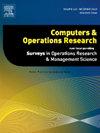基于规则的启发式和线性规划模型在女性技术指导方案中分配学员和导师的比较
IF 4.1
2区 工程技术
Q2 COMPUTER SCIENCE, INTERDISCIPLINARY APPLICATIONS
引用次数: 0
摘要
女性在科学、技术、工程和数学(STEM)领域的代表性仍然明显不足,但积极的师徒关系可以帮助她们减轻在这些领域学习和工作时面临的挑战。为了支持STEM领域的女大学生,奥克兰理工大学(AUT)于2019年建立了“科技女性指导计划”。最初,学员和导师的匹配是手工完成的,但随着计划的普及,这个过程变得越来越耗时。本研究通过基于被徒弟和导师属性的自动化匹配过程,解决了与将徒弟分配给导师相关的挑战。提出了一种基于规则的启发式算法,并与线性规划方法进行了比较。通过数值实验来评估这些算法在不同场景下的性能。基于规则的启发式提供了一种简单且易于理解的方式来分配学员和导师,其性能几乎与LP方法提供的最优匹配一样好。将这些算法应用于AUT女性技术指导计划的真实数据,发现它们在几个绩效指标上优于手动匹配。本文章由计算机程序翻译,如有差异,请以英文原文为准。
Comparison of a rule-based heuristic and a linear programming model for assigning mentees and mentors in a women in technology mentoring programme
Women remain significantly underrepresented in the fields of science, technology, engineering and mathematics (STEM), but positive mentoring relationships can help mitigate the challenges they face when studying and working in these areas. To support female university students in STEM, the Auckland University of Technology (AUT) established the Women in Tech mentorship programme in 2019. Initially, the matching of mentees and mentors was achieved manually, but as the programme’s popularity grew, this process became increasingly time consuming. This study addresses the challenges associated with assigning mentees to mentors by automating the matching process based on mentee and mentor attributes. A rule-based heuristic is proposed and compared with a linear programming (LP) approach. Numerical experiments were conducted to evaluate the performance of these algorithms across various scenarios. The rule-based heuristic provides a simple and easily understandable way to allocate mentees and mentors that performs nearly as well as an optimal matching provided by the LP approach. Applying these algorithms to real data from the AUT Women in Tech mentorship programme, it was found that they outperformed manual matching in several performance metrics.
求助全文
通过发布文献求助,成功后即可免费获取论文全文。
去求助
来源期刊

Computers & Operations Research
工程技术-工程:工业
CiteScore
8.60
自引率
8.70%
发文量
292
审稿时长
8.5 months
期刊介绍:
Operations research and computers meet in a large number of scientific fields, many of which are of vital current concern to our troubled society. These include, among others, ecology, transportation, safety, reliability, urban planning, economics, inventory control, investment strategy and logistics (including reverse logistics). Computers & Operations Research provides an international forum for the application of computers and operations research techniques to problems in these and related fields.
 求助内容:
求助内容: 应助结果提醒方式:
应助结果提醒方式:


